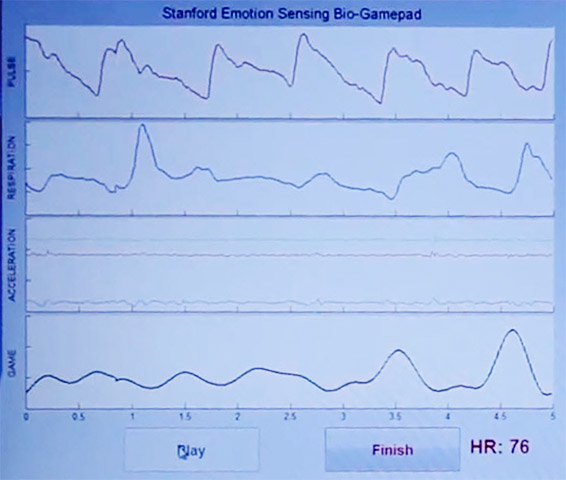A video game controller that can sense players’ emotions
April 8, 2014
Corey McCall, a Stanford University doctoral candidate, is developing a handheld game controller that monitors the player’s autonomic nervous system activity to indicate when a player is bored.
The prototype controller was born from research conducted in the lab of Gregory Kovacs, a professor of electrical engineering, in collaboration with Texas Instruments.
Autonomic nervous system activity occurs when you get excited or bored, happy or sad, for example, as indicated by your heart rate, respiration rate, temperature, perspiration, and other key bodily processes. Measuring these outward signs offers a way of reverse engineering what’s occurring in emotion centers of the brain.
“You can see the expression of a person’s autonomic nervous system in their heart rate and skin temperature and respiration rate, and by measuring those outputs, we can understand what’s happening in the brain almost instantaneously,” said McCall, the leader on the game controller project.
As McCall worked out other ways to measure autonomic activity, he realized that he could easily monitor people in various mental states as they played video games and that he could gather most of the data he needed straight from test subjects’ hands.

Processed data from controller, top-to-bottom: light-based pulse measurement, respiration rate, accelerometer, and related game activity (credit: Corey McCall)
McCall added a 3-D printed plastic module packed with sensors to an Xbox 360 controller. Small metal pads on the controller’s surface measure the user’s heart rate, blood flow, the rate of breath, and how deeply the user is breathing. A light-operated sensor gives a second heart rate measurement, and accelerometers measure how frantically the person is shaking the controller.
Meanwhile, custom-built software gauges the intensity of the game, in this case, a simple but fast-paced racing game in which the player must drive over colored tiles in a particular sequence.
McCall can then compare all this data to generate an overall picture of the player’s level of mental engagement, which can be used to alter the pace of gameplay to better suit the player.
“If a player wants maximum engagement and excitement, we can measure when they are getting bored and, for example, introduce more zombies into the level,” McCall said. “We can also control the game for children. If parents are concerned that their children are getting too wrapped up in the game, we can tone it down or remind them that it’s time for a healthy break.”
